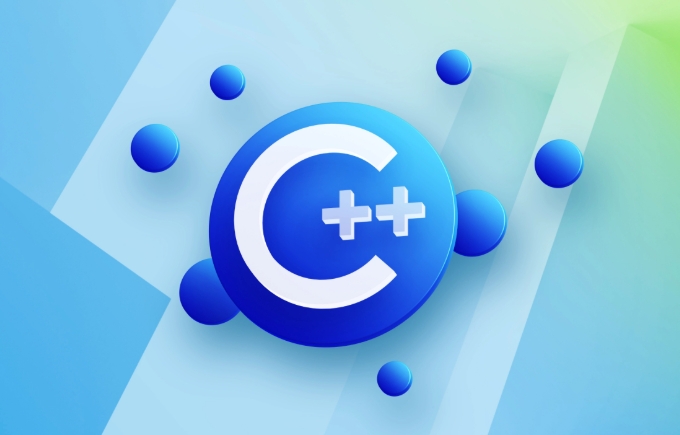什麼是C 17中的STD ::文件系統?
std::filesystem in C 17 是一個用於跨平台文件系統操作的標準庫模塊,提供了path、file_status、directory_entry等核心組件,支持檢查文件存在性、遍歷目錄、創建刪除目錄及處理路徑等功能。 1. 它取代了以往依賴平台API或第三方庫的做法;2. 支持常見操作如exists()、create_directory()、directory_iterator等;3. 自動處理不同系統的路徑格式差異;4. 使用時需注意異常處理、平台差異和性能問題。

std::filesystem in C 17 is a standard library module that provides a set of classes and functions for manipulating files, directories, and paths in a portable way. Before C 17, developers often relied on platform-specific APIs or third-party libraries like Boost to handle file system operations. Now, with std::filesystem , you can write code that works across different operating systems without needing external dependencies.

Key Features of std::filesystem
The main components of std::filesystem include:

- path : Represents a filesystem path (file or directory), handling string conversions, concatenation, and more.
- file_status : Holds information about a file's type and permissions.
- directory_entry : Represents an entry in a directory.
- directory_iterator : Iterates through the contents of a directory.
- recursive_directory_iterator : Traverses directories recursively.
- Functions for checking file existence (
exists()), copying files (copy_file()), creating directories (create_directory()), getting file size (file_size()), and more.
These tools make it easier to work with files and folders without relying on OS-specific calls.
Common Use Cases and Examples
Here are some everyday tasks you can do with std::filesystem .

Check if a File Exists
This is one of the most basic but essential operations:
#include <filesystem>
namespace fs = std::filesystem;
if (fs::exists("example.txt")) {
std::cout << "File exists\n";
} You can also check if it's a regular file or a directory using is_regular_file() or is_directory() .
List Files in a Directory
Use directory_iterator to loop through files:
for (const auto& entry : fs::directory_iterator(".")) {
std::cout << entry.path() << "\n";
}This prints all files and folders in the current working directory.
If you need to go into subdirectories too, just replace directory_iterator with recursive_directory_iterator .
Create and Remove Directories
Creating a directory is straightforward:
fs::create_directory("new_folder");And removing one:
fs::remove_all("new_folder"); // Removes even if not empty Note: remove() deletes only empty directories. For non-empty ones, use remove_all() .
Handling Paths Correctly
One of the biggest advantages of std::filesystem is how it handles paths consistently across platforms. You don't have to worry about backslashes vs. forward slashes — it takes care of that under the hood.
For example:
fs::path p = "data" / "images" / "logo.png"; std::cout << p; // Outputs "data/images/logo.png" on Linux/macOS, "data\images\logo.png" on Windows
You can also extract parts of a path easily:
-
p.parent_path()returns"data/images" -
p.filename()gives"logo.png" -
p.extension()gives".png"
This makes building and parsing paths much cleaner than using string manipulation.
Things to Watch Out For
While std::filesystem is powerful, there are a few gotchas:
- It may throw exceptions by default. If you don't want that, pass an error code object as the last argument to many functions.
- Not all operating systems support every feature — for example, certain permission-related functions behave differently on Windows and Unix-like systems.
- Performance can be an issue when iterating large directories or deeply nested structures.
So always test your code on target platforms and consider wrapping filesystem calls in try-catch blocks unless you're sure they won't fail.
That's the core of what you need to know about std::filesystem . It's not overly complicated, but it does take some time to get used to the types and methods. Once you're familiar with them, though, it becomes a solid part of your C toolkit for file management.
以上是什麼是C 17中的STD ::文件系統?的詳細內容。更多資訊請關注PHP中文網其他相關文章!

熱AI工具

Undress AI Tool
免費脫衣圖片

Undresser.AI Undress
人工智慧驅動的應用程序,用於創建逼真的裸體照片

AI Clothes Remover
用於從照片中去除衣服的線上人工智慧工具。

Clothoff.io
AI脫衣器

Video Face Swap
使用我們完全免費的人工智慧換臉工具,輕鬆在任何影片中換臉!

熱門文章

熱工具

記事本++7.3.1
好用且免費的程式碼編輯器

SublimeText3漢化版
中文版,非常好用

禪工作室 13.0.1
強大的PHP整合開發環境

Dreamweaver CS6
視覺化網頁開發工具

SublimeText3 Mac版
神級程式碼編輯軟體(SublimeText3)
 在C中解釋RAII
Jul 22, 2025 am 03:27 AM
在C中解釋RAII
Jul 22, 2025 am 03:27 AM
RAII是C 中用於資源管理的重要技術,其核心在於通過對像生命週期自動管理資源。它的核心思想是:資源在構造時獲取,在析構時釋放,從而避免手動釋放導致的洩漏問題。例如,在沒有RAII時,文件操作需手動調用fclose,若中途出錯或提前return就可能忘記關閉文件;而使用RAII後,如FileHandle類封裝文件操作,離開作用域後會自動調用析構函數釋放資源。 1.RAII應用於鎖管理(如std::lock_guard)、2.內存管理(如std::unique_ptr)、3.數據庫和網絡連接管理等
 c向量獲得第一個元素
Jul 25, 2025 am 12:35 AM
c向量獲得第一個元素
Jul 25, 2025 am 12:35 AM
獲取std::vector的第一個元素有四種常用方法:1.使用front()方法,需確保vector非空,語義清晰且推薦日常使用;2.使用下標[0],同樣需判空,性能與front()相當但語義稍弱;3.使用*begin(),適用於泛型編程和STL算法配合;4.使用at(0),無需手動判空但性能較低,越界時拋出異常,適合調試或需要異常處理的場景;最佳實踐是先調用empty()檢查是否為空,再使用front()方法獲取第一個元素,避免未定義行為。
 在C中使用STD ::可選
Jul 21, 2025 am 01:52 AM
在C中使用STD ::可選
Jul 21, 2025 am 01:52 AM
要判斷std::optional是否有值,可使用has_value()方法或直接在if語句中判斷;返回可能為空的結果時推薦使用std::optional,避免空指針和異常;不應濫用,某些場景下布爾返回值或獨立bool變量更合適;初始化方式多樣,但需注意使用reset()清空值,並留意生命週期和構造行為。
 C標準庫解釋
Jul 25, 2025 am 02:11 AM
C標準庫解釋
Jul 25, 2025 am 02:11 AM
C 标准库通过提供高效工具帮助开发者提升代码质量。1.STL容器应根据场景选择,如vector适合连续存储,list适合频繁插入删除,unordered_map适合快速查找;2.标准库算法如sort、find、transform能提高效率并减少错误;3.智能指针unique_ptr和shared_ptr有效管理内存,避免泄漏;4.其他工具如optional、variant、function增强代码安全性与表达力。掌握这些核心功能可显著优化开发效率与代码质量。
 C功能示例
Jul 27, 2025 am 01:21 AM
C功能示例
Jul 27, 2025 am 01:21 AM
函數是C 中組織代碼的基本單元,用於實現代碼重用和模塊化;1.函數通過聲明和定義創建,如intadd(inta,intb)返回兩數之和;2.調用函數時傳遞參數,函數執行後返回對應類型的結果;3.無返回值函數使用void作為返回類型,如voidgreet(stringname)用於輸出問候信息;4.使用函數可提高代碼可讀性、避免重複並便於維護,是C 編程的基礎概念。
 C折表示例
Jul 28, 2025 am 02:37 AM
C折表示例
Jul 28, 2025 am 02:37 AM
C foldexpressions是C 17引入的特性,用於簡化可變參數模板中的遞歸操作。 1.左折疊(args ...)從左到右求和,如sum(1,2,3,4,5)返回15;2.邏輯與(args&&...)判斷所有參數是否為真,空包返回true;3.使用(std::cout
 迭代時從矢量擦除
Aug 05, 2025 am 09:16 AM
迭代時從矢量擦除
Aug 05, 2025 am 09:16 AM
刪除元素時若正在迭代,必須避免使用失效迭代器。 ①正確做法是使用it=vec.erase(it),利用erase返回的有效迭代器繼續遍歷;②批量刪除推薦“erase-remove”慣用法:vec.erase(std::remove_if(vec.begin(),vec.end(),條件),vec.end()),安全且高效;③可使用反向迭代器從後往前刪除,邏輯清晰但需注意條件方向。結論:始終用erase返回值更新迭代器,禁止對已失效迭代器執行 操作,否則導致未定義行為。








